Amazake is my favourite traditional Japanese sweet drink. It always reminds of me the casual job I had at a shrine in Ise (the Japanese city I used to live in) from New Year’s Eve to New Year’s Day. Japanese people have a custom of visiting shrines on New Year’s Eve and New Year’s Day, which is called “Hatsumode”. I was employed as a registered nurse who provide first aide for worshippers of Ise Shrine and my uncle and aunt who live nearby the Ise shrine, brought me Amazake to drink during my breaks. It was so comforting and delicious in the cold winter.
There are two types of Amazake; one made from Sakekasu (sake lees) and another made from Kome koji (rice koji, a kind of mold grown on rice). Despite what the name indicates, Amazake contains low or no alcohol. Sugar and water added to the sakekasu Amazake, because sake lees is not sweet and this one does contain a low amount of alcohol.
The Kome koji one becomes naturally sweet when the rice is fermented by koji. The one I had at Ise shrine was made from sake lees, which contains a little bit of alcohol, but I prefer koji amazake for the mellow sweetness and because it is healthier, so I am going to show you how to make this Amazake in an easy way for people who live outside of Japan.
Amazake made from Koji has a mellow sweetness. It is hard to describe so you need to taste it for yourself. Ready-made Amazake is readily available to purchase from local supermarkets and convenience stores in Japan, as superfoods like fermented food are taking Japan by storm at the moment. But in my opinion, freshly made Amazake out of a pot at home is the most delicious! And we can experience it even if we live outside of Japan as long as you can get Rice Koji
Amazake requires only two or three ingredients. You can make Amazake with just koji and water, or Koji, cooked rice, and water. Making Amazake consists of a few basic steps.
Koji only
Step 1: combine koji and water well
Step 2: Keep the mixture in 55-60 C degree (131-149F)environment for 6-8 hours.
Koji + cooked rice
Step 1: mix cooked rice and water(60 C degree)(140F)
Step 2: add koji to it and combine well
Step 3: Keep the mixture in 55-60 C degree (131-149F) environment for 6-8 hours.
There are many ways to keep the 55-60 C degree ((131-149F) environment for the mixture to get fermented. Japanese people usually use a rice cooker, a yoghurt maker, a thermos, or Styrofoam. You can even purchase a kitchen gadget specifically made to make Amazake as the drink is so popular. Because I don’t live in Japan now, I am not able to purchase that gadget easily so I use the other methods. I have tried a rice cooker, yoghurt maker, and Thermos and an Instapot (using the yogurt making function).
This drink only requires a few ingredients and simple steps but the difficult part is controlling the temperature. Why does it need to be kept in 55-60 C degree(131-140F)? Because 60 C degrees(140F) is the most suitable temperature for the enzyme, which is called amylase (made from Aspergillus), to break down the rice starch into glucose. And that is the reason that Amazake is so sweet without adding sugar.
So I have tried 4 different ways to keep the fermentation environment 55-60 C degree(131-149F). My verdict is that the rice cooker was the easiest way to keep the temperature 55-60 C (131-149F) and therefore made the most sweet and delicious Amazake.
Using a yoghurt maker was ok but I had to reheat the mixture at around 4 hours and also change the boiling water to keep the container warm. Amazake was successfully made but was not as sweet as Amazake made in the rice cooker even though it was kept in for 8 hours whereas the rice cooker was stopped at 6 hours.
Amazake made in a thermal pot also needed to be reheated at around 4 hours. It depends on how good the thermal pot is too, but I found it is difficult to keep the mixture temperature at 60 C degree(140F). And the mixture needed to be left a lot longer than 6-8 hours in lower temperature ending up with a slightly sour taste.
Since I bought an Instapot for Christmas, I decided to try it to make Amazake but it is not really good for this. I used the yoghurt making function but the temperature set for this function is about 40-45 degree Celsius (104-113F) which is quite low and for that reason the mixture was left a little bit longer and the Amazake ended up having a slightly sour taste like yoghurt.
Since I like this drink and because it has many health benefit, I am going to start making it regularly so I am going to purchase this Yoghurt maker because this one can be set to different temperatures and also set different times as well.
This drink is very popular in Japan and is even said to be a “beauty drink” or same as “hospital medical drips” because it contains Vitamin B1, B2, B6, Folic acid, Dietary fibre, Oligosaccharide, Cysteine, Arginine, Glutamine, and Glucose. Because it contains Vitamin B’s, it promotes the metabolism of the cell generation and to activate the skin cells’ turnover so it is drunk by Japanese women as a beauty drink. The dietary fibre and oligosaccharides in amazake also promote smooth bowel movements, which eliminates rough skin condition.
I like to drink this either in the morning to charge my brain and body, and sometimes at night before bed when I am tired and want to revitalise my body. The Amazake can be served hot or cold like Lemonade (link) and also can be used as an ingredient for different dishes, sweets, and baking. It is quite condensed and the sweetness is intense. If the Amazake is too sweet or too thick or rich, it can be diluted with hot or cold water. I hope you enjoy this recipe!
If you liked my recipe for Amazake, please rate it and leave a comment below. Also, don’t forget to follow me on Youtube, Pinterest, Facebook and Instagram to keep up to date with all the latest happenings on Chopstick Chronicles. Don’t forget to use the hashtag #ChopstickChronicles so I see your wonderful creations!
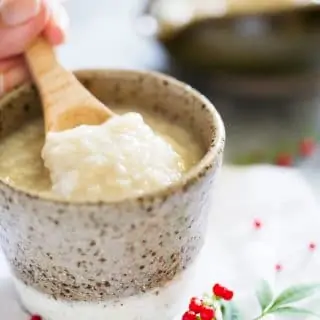
Amazake
Ingredients
Koji and Cooked rice
- 100 g Koji rice mold
- 150 g cooked rice
- 300 ml water
Koji only
- 100 g Koji
- 100 ml water
Instructions
Koji and cooked rice
- Place cooked rice in a bowl.
- Pour 65-70 degree Celsius (149-158F)hot water into the bowl and mix with the cooked rice. *1
- Add koji to the bowl and combine them all together well.
- Check the mixture temperature to make sure it is around 60 degree Celsius(140F).
- Place the mixture into a rice cooker, yoghurt maker, oven, etc. (anything that can keep it at 60c[140F]) and leave it for about 6-8 hours, stirring occasionally. *2
- If using Rice Cooker, set the rice cooker for “keep warm” and leave the lid slightly open with kitchen cloth covered on the top.
- Stop whatever is used, put the amazake into a pan over medium heat for 5 minutes after it has cooked for 8 hours (do not let the temperature go above 80c degrees). By doing this, it will stop further fermentation process.
- Pour it into a sterilized jar and keep it refrigerated for up to about 10 days. *3
- Serve hot or leave in the fridge to cool and serve cold!
Koji only
- Place Koji in a bowl.
- Pour 65-70 degree Celsius(149-158F) hot water into the bowl and mix well.
- Check the mixture temperature to make sure it is around 60 degree Celsius(140F).
- Place the mixture into a rice cooker, yoghurt maker, oven, etc. (anything that can keep it at 60C[140F]) and leave it for about 6-8 hours, stirring occasionally. *2
- Stop whatever is used, put the amazake into a pan over medium heat for 5 minutes after it has cooked for 8 hours (do not let the temperature go above 80c degrees). By doing this, it will stop further fermentation process.
- Pour it into a sterilized jar and keep it refrigerated for up to about 10 days. *3
- Serve hot or leave in the fridge to cool and serve cold!
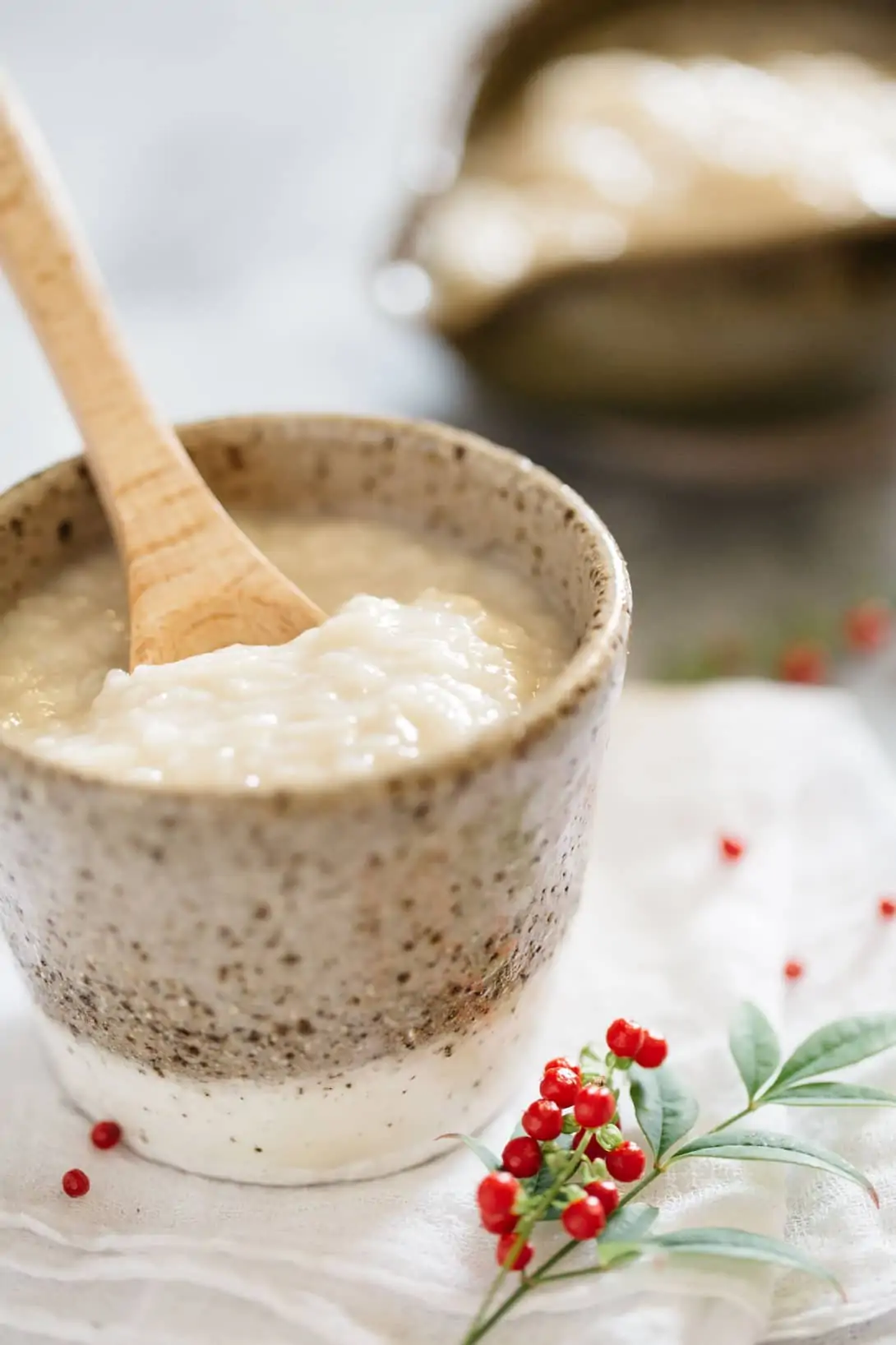
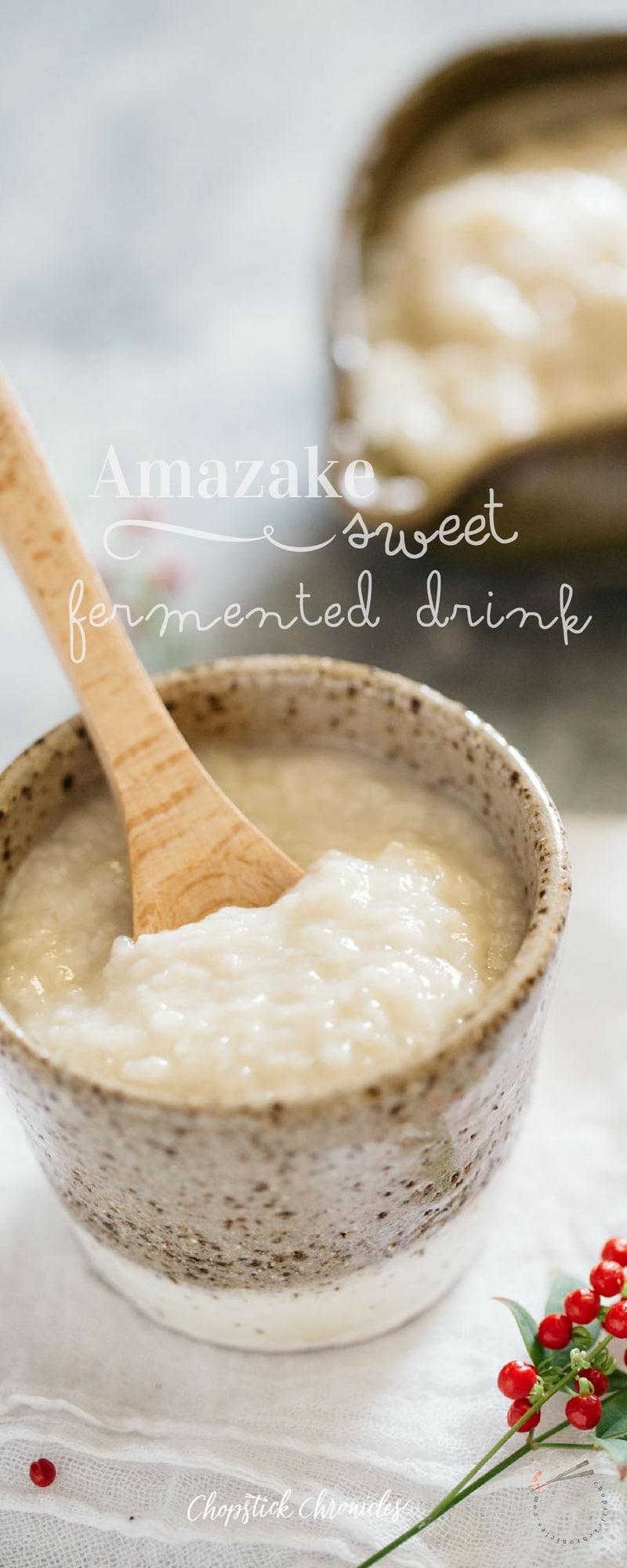
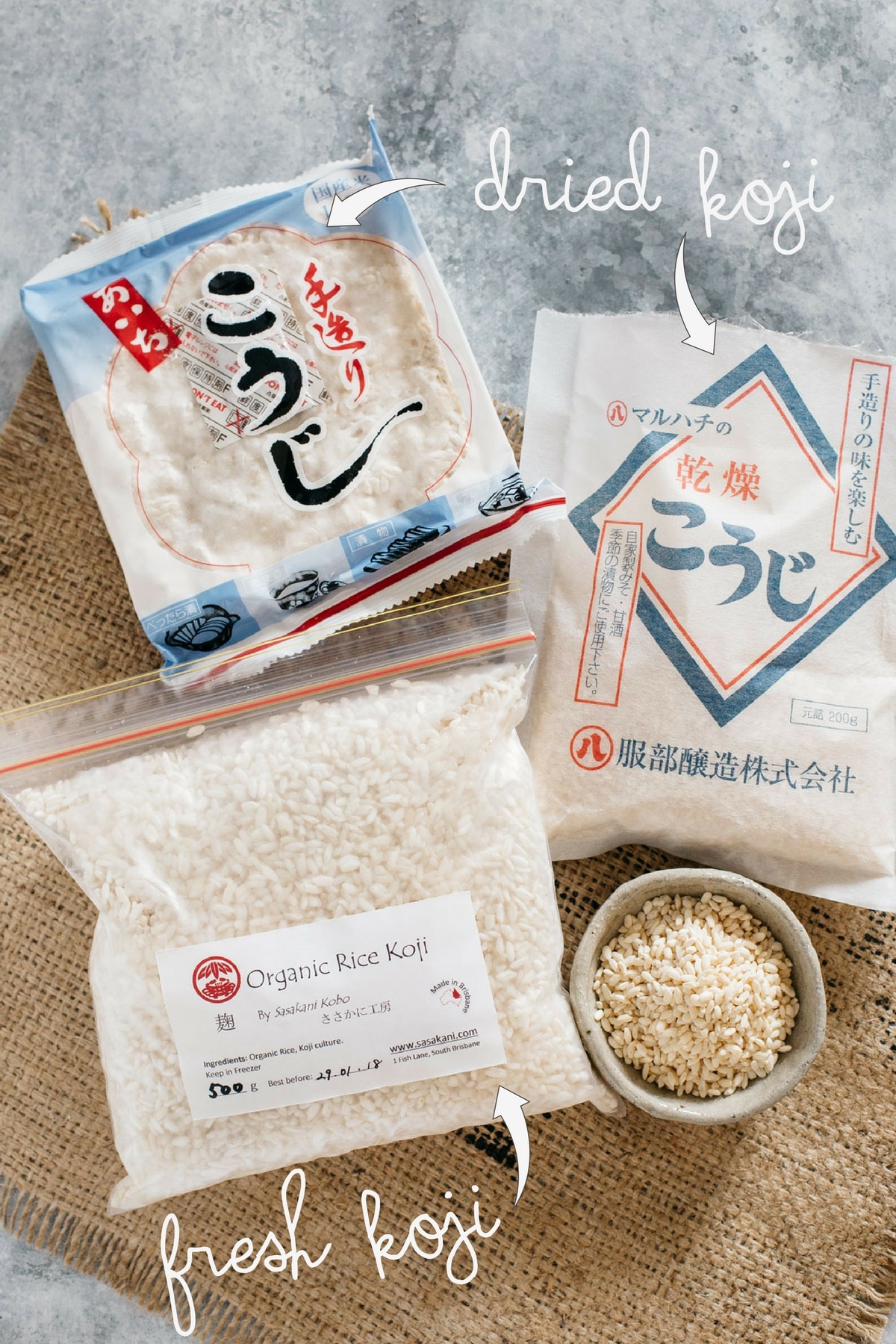

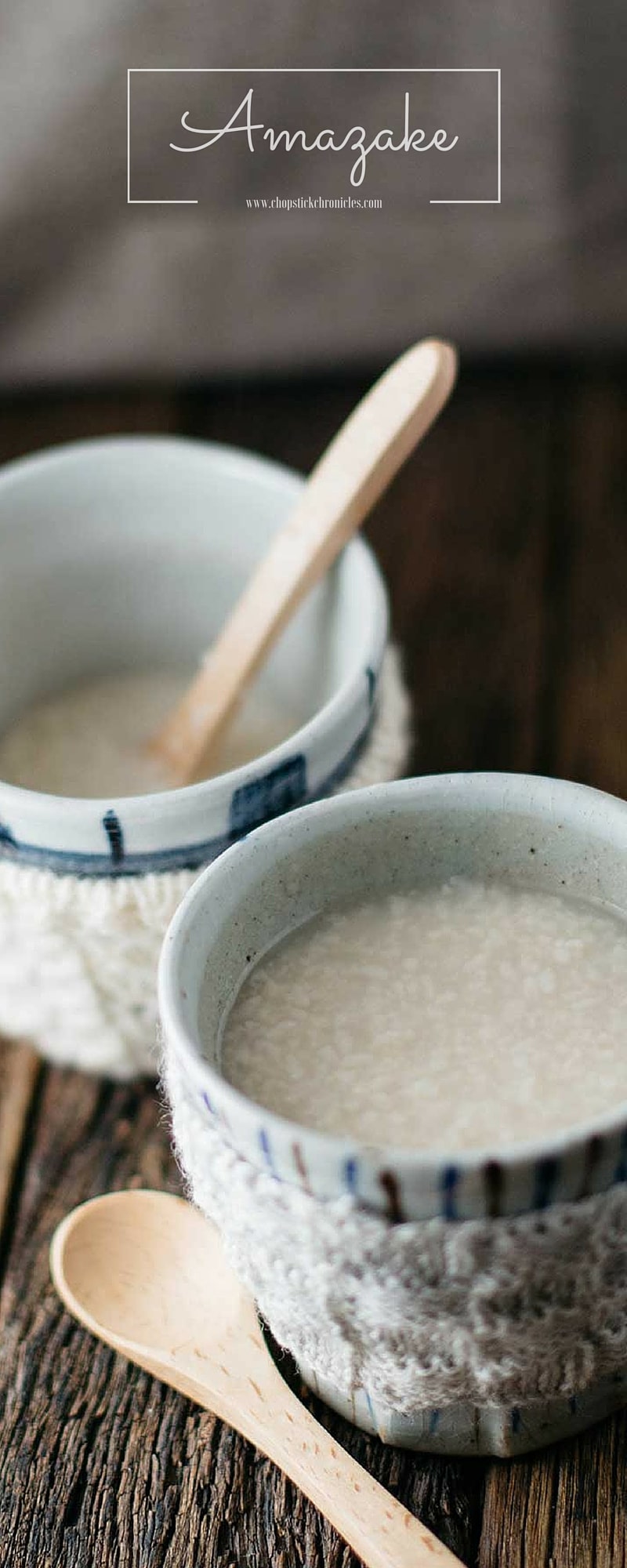




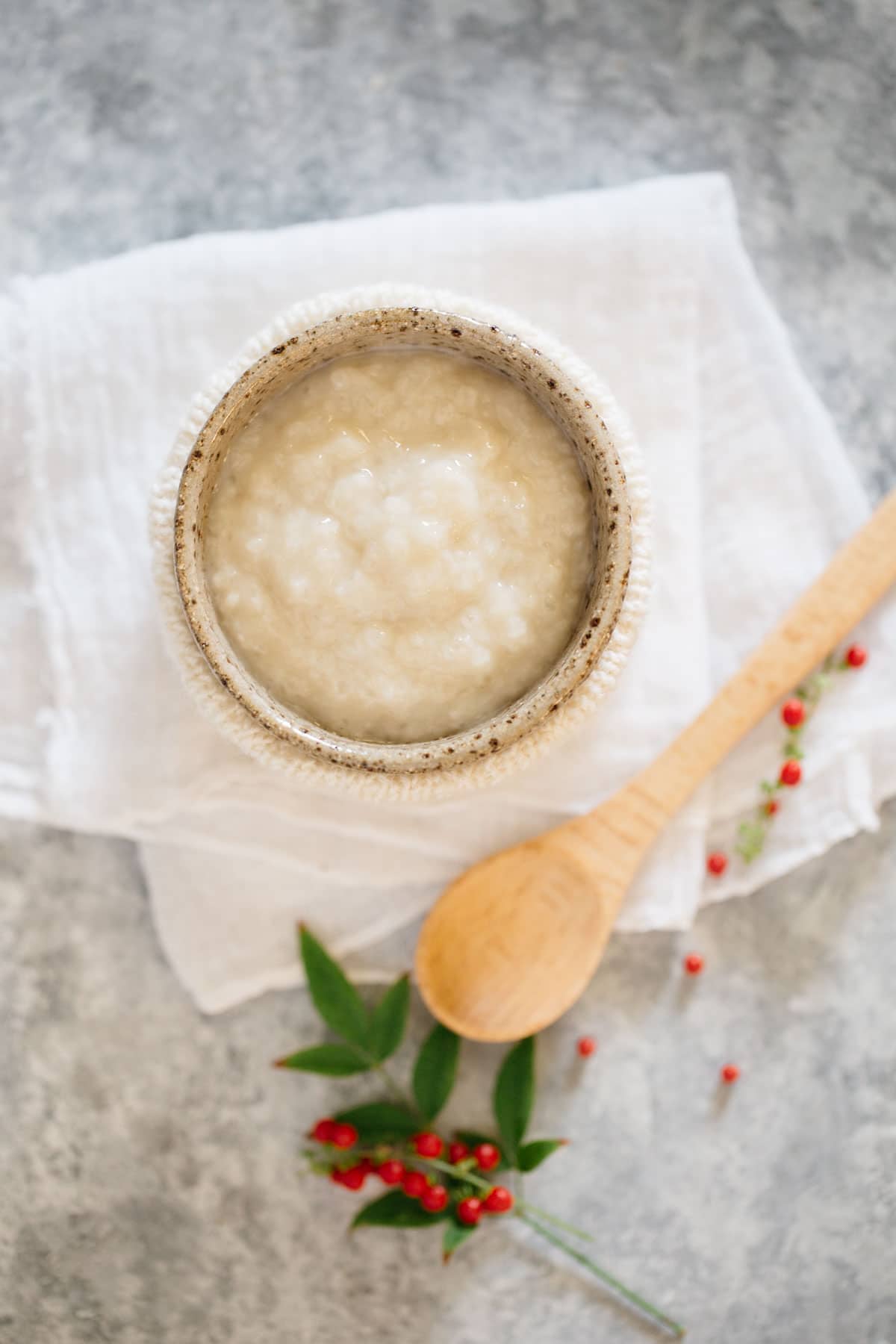
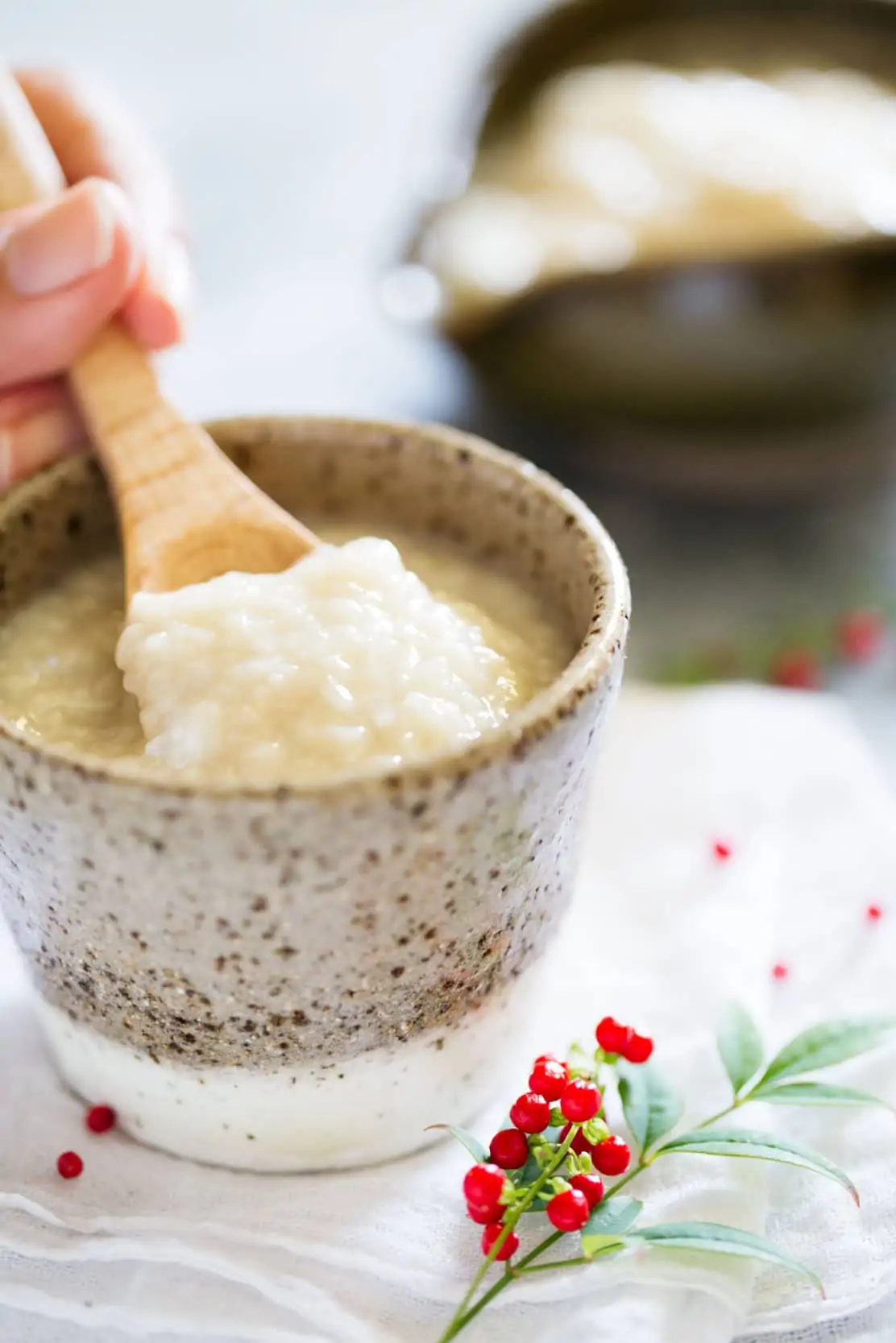
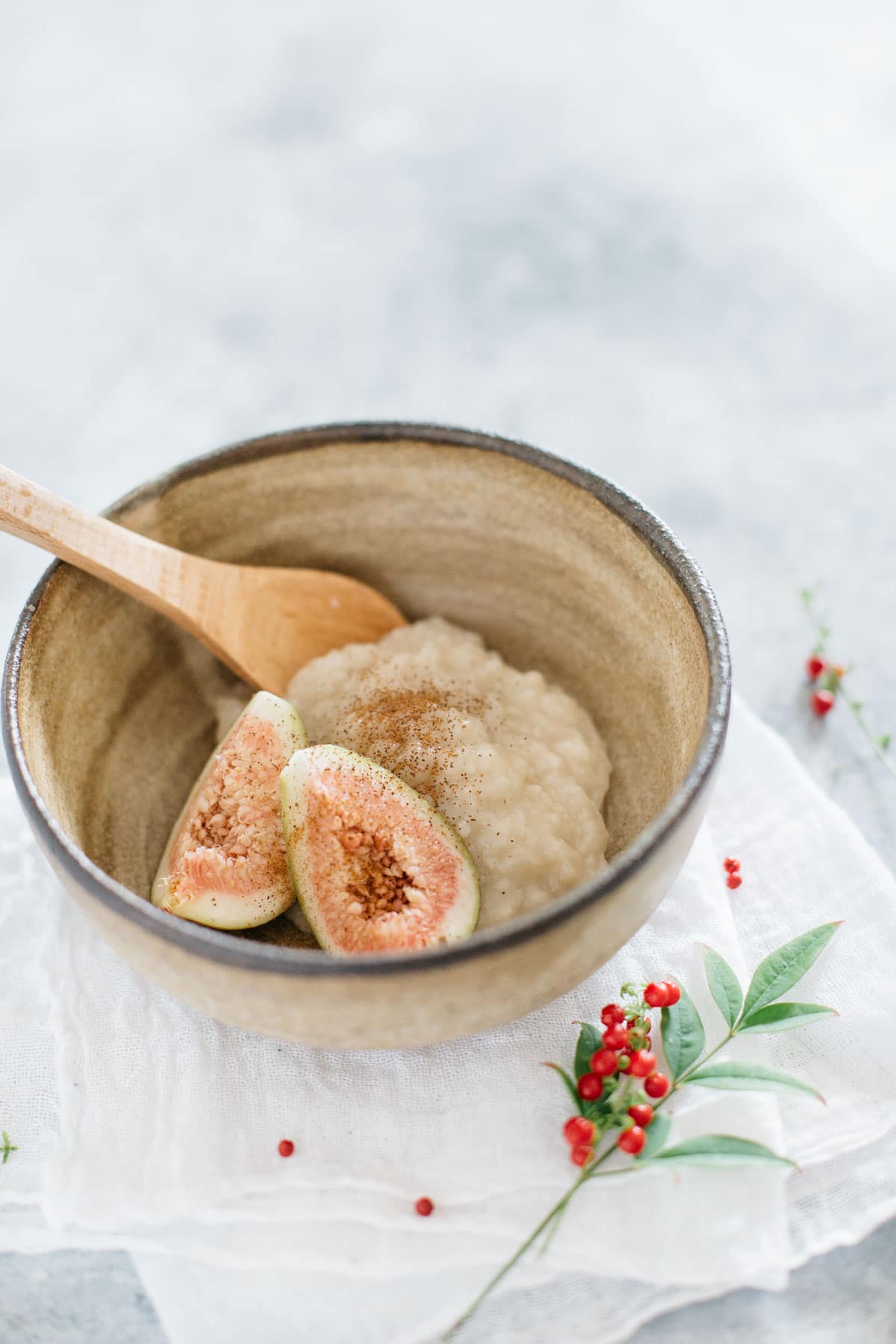
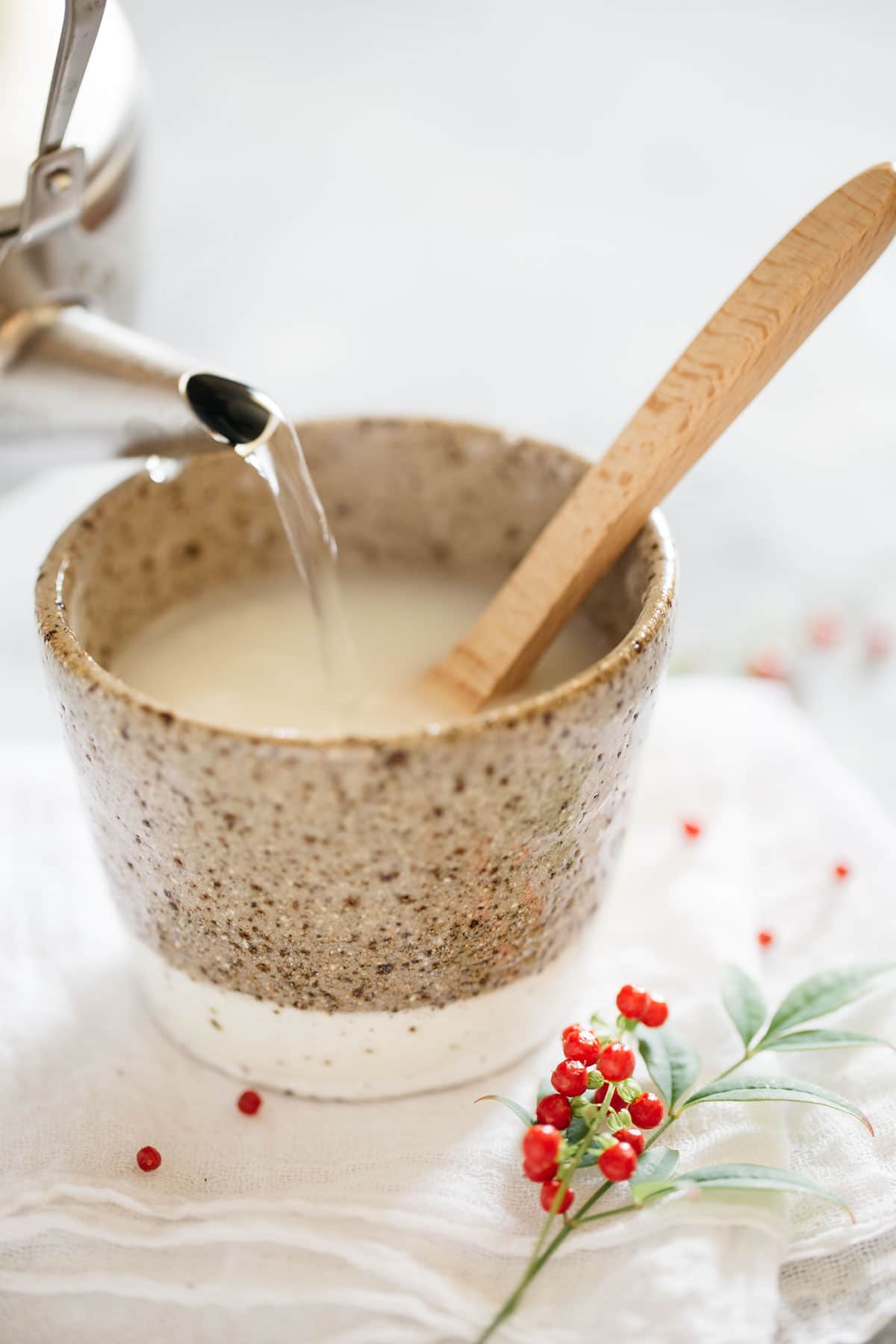

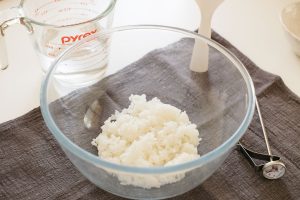
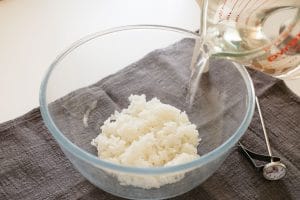
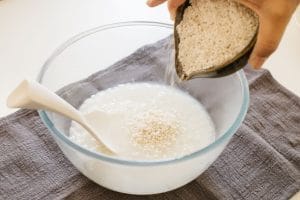
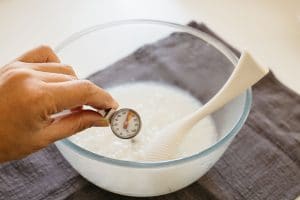
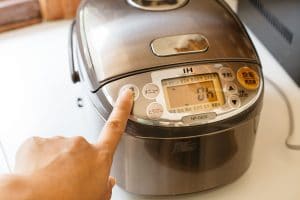
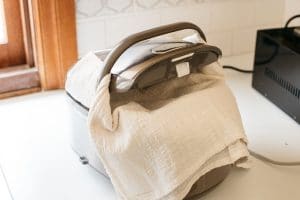
Hi Shihoko. Here’s a tip you might find useful. As you say, Instant Pot is no good for amazake because it does not have the correct temp. this purpose. However, if you use a Tefal multicooker, it has the sous-vide function where the temp. can be adjusted to 58 degrees, which is what I use for my amazake. You can set it for six hours only, but no problem because you just re-set for another 2 hours. Perfect amazake every time! Hope this is useful.
Hi Heidi, thank you so much for sharing the information. It is really useful 😀 THank you!
Hi, I have made my first batch and it worked beautifully.
– Can I use some of this batch as a starter for another batch or do you need to obtain Koji every time?
– Can you double the rice and water and just ferment for a longer time for a larger batch?
Hi Bill, great questions. Thank you. This is what I think. Amazake is not made by fermenting koji,but by increasing the activity of the yeast produced by the koji to break down the starch in the rice. The “kōbo” yeast will not grow like Aspergillus oryzae. So, I think you need to get koji every time and doubling rice and water does not increase growth of “kobo”.
Hello, do you know what 100g koji rice would be in cups?
Thank you!
Hi Grace, it will be 2/3 cup 😀
Hi there, Wonderful information. I was wondering if we can turn amazake into sake? My friend made a big batch from this recipe that I sent her and she gave me a gallon of amazake which I can not consume right away. So I thought maybe we could turn it into Sake as a way of preserving it. Or could I just freeze some of it? Thank you inadvance.
Esbet
Hi Esbet, Despite the name “ama(means sweet)-zake(sake)” Amazake made from koji is not alcohol so you can not turns into sake but as you mention, you can freeze it 😀
Hi Shihoko-San! For the best temperature control, try using a sous vide cooker, with the Koji rice/ rice mixture submerged within a glass jar. The sous vide cooker will give you very precise temperature control (within 0.1°) The top of the koji mixture should be below the water level to ensure it is completely heated, and the lid of the jar containing the koji mixture should be above the water level. You can set the temperature to 55°C, set the timer to 9 hours, and that’s it! You don’t need to even think about looking at it until the timer beeps. Every batch turns out perfectly 😋
Hi Michael san, Thank you for sharing the idea of using a sous vide. I did not think of. I don’t have it but have been considering to buy it. Now I have more reason to get it 😀 waiting for a good discount sale time!
Excellent method for Amazake – but please tell me if the Nutritional values you posted are for the whole recipe or one serving? If one serving, how many ounces or grams? Thanks so much.
Hi Donna, the Nutritional value is for a whole recipe.
Hello! I’ve never had Amazake before and I’ve just made it up with your instructions using fresh (wet) Koji. Is it supposed to be very salty? I’m puzzled as to whether I’ve done something wrong.
Hi Angelique, no it supposed to be sweet.
You must have used shio koji which is a fermented mix of salt, koji and water – usually it’s used for marinating meat and won’t work well for amazake.
I think you used shio koji, not koji, if it is salty 🙂
Thank you CO, it could be the reason.
You must have used shio-koji(salted koji).
Nice product I want to make
Thank you for making this 😀
Hi
Thanks for the great recipes, i have tried heaps and the instructions are super helpful.
And the photos amazing! 🙂
I live in Australia and am able to find Japanese products quite easily so cooking up a Japanese meal is easy.
Just starting a diet and don’t wanna miss my Amazake smoothie.
With the Amazake, how big is the 1 serving in ml?
Hi Nash, Thank you for your comment 😀 There is not standard serving size. You can drink as much as you would like though it is quite sweet so I usually only have about 1/2 cup which is 125ml 😀 Hope it helps.
So the nutrition below the recipe is for 1/2 cup Amazake?
Calories: 595kcal; Carbohydrates: 128g
Cheers 🙂
Hi, I really like the look of this recipe but the koji is expensive so I’m wondering if you can make it out of the sake lees which I can see on Rakuten for $6.50 a kg (compared to $24 for 400 g for the koji.) Here is the Rakuten link https://global.rakuten.com/en/store/naebasyuzo/item/1000000107/
I live in Sydney so the only way I can see to buy Koji is online (unless maybe I go to the big Japanese supermarket at Northbridge.)
Thank you for sharing your recipes.
Hi Catherine, I am sure there are more Japanese grocery stores than it in Brisbane.Koji packet is about A$7-9 in Brisbane. You can make amazake from sake lees but making method is different.
Thank you for sharing this recipe – I love your website! Have you ever used leftover amazake to make the next batch? I’m used to making yogurt and sourdough bread from a starter that is carried over each time and I’m wondering if that would work for amazake. Thanks again!
Thank you Lori, I usually consume them all so no left over. I am not sure if it work because leftover amazake will not have enough koji in it to make another batch 😀
Hi Shihoko san
Thanks so much for share such healthy traditional Japan recipe.
I had use brown rice instead of white rice and the taste was a little sweet after 6 hours fermentation. Then after I blend the mixture into a thick liquid, the sweetness decrease. May I know the key point to taste more sweet and more like yohurt (a bit of acidic)? Many thanks.
Joyce
Hi Joice san, I sometimes use brown rice too. If it was only a little sweet, I think it did not ferment properly. Could you check the temperature? If the temperature is right, it should be very sweet and if you leave it more than 6 hours fermentation keep going till you taste like yoghurt. If you don’t like acidic taste, after 6 hours, bring to boil, it will stop fermentation.
Hi Shihoko
Your explanation and photography are top rate! I’d like to know if you have already bought and used the Tanika yoghurt maker? How do you find it?
I too live in Australia, in Sydney. Do you buy the rice koji from Amazon or any particular shop or online shop?
Appreciate your response.
Hi Rei Thank you. I am in Japan now and bringing Tanika yoghurt maker back to Australia soon. I bought it on Amazon. TANICA Yogurt Maker I buy rice koji from a Japanese lady lives nearby where I live in Brisbane but any Japanese grocery stores in Sydney should have 😀 Please let me know if you can’t find any.
I buy rice koji from a Japanese lady lives nearby where I live in Brisbane but any Japanese grocery stores in Sydney should have 😀 Please let me know if you can’t find any.
amazing i love it great recipe
thank you very much, Pablo!
How about using the instantpot in yogurt mode as a double boiler, and adding hot water to raise the preset temperature?
Do you think it would remain warmer long enough?
Hi Celia, It might work as long as the hot water is not too hot (over 70 celsius degree/158 f) 😀
You make it look so easy!! I’l try preparing it this weekend, hope it ends up looking as good as yours. Thanks for sharing!
Hi Isadora, it look easy and it is easy, only difficult part would be keeping the fermenting temperature right.
This food and photography looks wonderful, Thanks for sharing!!!
Thank you Aria 😀
Thank you for sharing your recepi. I also fun of fermented ingredients. Good to know Japanese grocery shops sell rice mold. That never crossed my mind. Hopefully one that is close to me in Bris sells it. I definitely have it go with your recepi. Give me luck. My challenging part will be keeping 60℃ for 8 hours. Do you have any key to success?
Ohhhh Mari san Arigatou. You can order on line too. I am going to make brown rice koji because it is healthier and more nutrient dense. Sasakani Kobo in Brsibane or GC making it in QLD. Do you have a rice cooker? I just leave it in the rice cooker the lid open over night:D
One of my holiday fun will be it. I will try the lemonade version too. I need to be full charged after the long-11weeks working term :p Just one more question. Do you keep a rice cooker thermal function on over night with the lid open?
I agree, Marisan. We have to look after ourselves with good nutrition to recharge our tired and stressed body for next term 😀 Yes leave it on thermal over night.
Hi Shihoko, thanks for the mention in your article. I’m totally addicted to Amazake too, sooooo good in the morning as a warm drink. 🙂
Just wanted to let people know the link you have has a typo, and that the best url to get to our site is simply sasakani.com
Thanks!
Oh, thank you. I will fix that 😀
I’ve gotten into fermentation more and more over the last 6 month’s too. But I’ve never tried let alone heard of this fermented rice drink! Fantastic!
Me too Emma, I am into fermentation food at the moment. My neighbour lend me a book called ” the art of fermentation” by Sandor Ellix Katz and it is New York Times Bestseller book. Amazake is mentioned in the book 😀